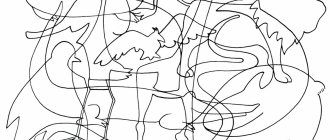Imagination is an extremely important mental process, but insufficient attention is usually paid to its development in preparation for school. Finding a non-standard solution to a problem, composing a story, writing an essay, doing creative work or coming up with an interesting research project - all this is impossible without a fairly good imagination. You can develop the imagination of preschool children with the help of various exercises and games, which will be discussed in this article.
On the characteristics of imagination in preschool children
In children, as in adults, experts distinguish the following types of imagination:
- Recreating. This type of imagination is inextricably linked with memory and imaginative thinking. With its help, a person can imagine what he heard or read about in a book.
- Creative imagination is the creation of new images by modifying already familiar ones (based on acquired experience).
- As a result of uncontrolled imagination, a person develops ideas that are not associated with any logic.
A person with a well-developed imagination has extraordinary creative thinking, which allows him to cope with various tasks more easily than others. Therefore, it is very important to encourage the child’s imagination and original solutions.
At preschool age, the imagination is most developed, because it is still difficult for children to act according to given rules. Imagination, like other mental processes, actively develops through play. While playing, children come up with new stories and use substitute objects (that is, a piece of paper becomes a movie ticket or a TV remote control becomes a mobile phone). Fantasy develops more actively if the child’s life is full of various events and vivid emotions, because new ideas are created on the basis of existing experience. It is also important to note that children often literally live in their own imaginary world and may confuse fantasy and reality. You need to carefully monitor the baby’s behavior and promptly introduce him to the real picture of the world in cases where this is necessary (for example, that you should not run out onto the road or stick your fingers into a socket).
We develop from an early age
So, the ability to imagine and fantasize develops most actively in children from 4 to 10 years old. But this does not mean that until then it is not worth improving these skills. From about 2 years old, you can begin to teach your child the ability to imagine. This will be a good foundation for improving it in the future.
How to encourage your baby to imagine?
- It is useful to play “make-believe” with him. This can be done in any situation. For example, walking on the street. You can show your baby the clouds and ask what they look like (to begin with, the mother can offer her own version). At this age, very simple images will appear, familiar to the baby (horse, house, bird, flower). You can ask about anything. Let's say, what are the sparrows chirping about: are they discussing delicious grains or a scary cat? What are the leaves on the tree whispering about: about the warm sun, about the evil wind, about harmful insects? Where does the cat run: after the mouse, to its children, to the owner for a treat? In this way, a small child will develop thinking, speech, and observation skills.
- At home and on the street, you can look for similarities between objects and toys familiar to the baby (what looks like a ball, a cube, a brick, a pyramid?).
- Construction using small parts (cubes, Legos) is very useful. You can add various boxes to your arsenal of “building materials”.
Games and exercises for developing imagination in preschoolers
- “What would happen if...” This word game perfectly develops the imagination of preschoolers. Ask your child what would happen if, for example, cars flew or adults became small and children became big, and so on. The topic can be absolutely anything, and the questions themselves can be funny and absurd - this will only further motivate the child to think creatively.
- "Tall tales." This exercise is similar to the previous game. But instead of asking questions, the adult voices the beginning of the story, and the child must continue it so that something unprecedented turns out. As a visual support in this game, you can use various plot pictures, illustrations, newspaper and magazine clippings, as well as drawings by the child himself. Telling stories is an extremely powerful way to develop your creative imagination.
- "Magic box" Children love dress up games. Place old clothes, masks, hats and other accessories in a box. Together with your baby, you can sew a real fancy dress costume from various materials. The child will be happy to put on a costume performance at home or have a fashion show.
Participate in your child’s games and come up with new stories together. This will not only help develop your baby’s imagination, but will also strengthen your relationship.
- "What does a cloud look like?" While walking with your baby, look around: look at the clouds, tree branches, shadows, puddles under your feet. Think about what they look like.
- “What can this thing be used for?” Invite your child to come up with as many ways as possible to use some simple objects (for example, a pencil, a piece of paper, a pebble, a sock, etc.). In a child's imagination, an ordinary glass can become a house for a bug, a signal light for a police car, or a musical instrument.
- Writing fairy tales. Together with the baby, compose a fairy tale on a topic that is close to the child. The presence in it of familiar plots and the child’s favorite characters are important factors necessary to captivate the child with the game.
- “Complete the figure.” Draw several geometric shapes on a piece of paper and ask your little one to add details to them so that each shape turns into an object.
- Blotography. A similar exercise can be performed using paints. Let your child put a colored blot on a piece of paper and then draw it into something meaningful.
- "Non-existent animal." This is not just a game, but a projective drawing test, which in the hands of a specialist can tell a lot about a child’s personality. At home, the task that underlies this technique will serve as an excellent way to develop the imagination of preschool children. Ask your child to come up with and draw an animal that does not exist (neither in life, nor in fairy tales, nor in cartoons) and give it a non-existent name. After the drawing is ready, discuss his work with your child: find out what kind of character the invented character has, what he likes to do and what he doesn’t, whether he has friends or enemies.
- Creative activities: drawing, modeling, appliqué.
Through creativity, children express their fantasies, feelings, thoughts and experiences. But in this case we are talking specifically about free creative activity, when the child decides for himself what he wants to depict. If we talk about coloring and making crafts based on patterns, then these activities only contribute to the development of fine motor skills and the ability to follow instructions, but not imagination.
- Construction. Every time your baby builds something new without using a pattern or instructions, he is using his imagination and learning to think creatively.
- Free role-playing play is the leading activity of preschoolers, therefore it is in it that all mental processes develop most actively and naturally. When playing with peers, children are in an imaginary situation with their own rules and distribution of roles.
Age characteristics
Developing the ability to imagine is impossible without fantasy. These abilities are most clearly manifested in the child’s play and creative activities. They improve by going through two age stages.
- 2–4 years. The baby’s ideas are still involuntary; they arise spontaneously under the influence of a specific situation.
- 4–6 years. Ideas and fantasies become arbitrary. At this time, games turn into plots, surrounding objects become the material with which the child embodies the images of his imagination. At the same time, it not only performs a cognitive and intellectual function, but also regulates the mental state. In the game, a child can become a rescue hero, a conqueror of the seas, space, courageous, brave, and endow himself with qualities that he lacks in reality. This helps the development of intelligence, moral, emotional spheres, knowledge of the surrounding reality, the formation of personality, the development of self-awareness, thinking, volition, speech. Cognitive capabilities expand.
One of the unwanted “side effects” of developing imagination is the appearance of fears. The child may begin to be afraid of imaginary monsters, ghosts, invisible people, etc. If this happens, try to protect the child from situations that can provoke the appearance of such fears (watching horror stories, computer games with scary characters). And, of course, take measures to rid your child of fears. Don't be afraid to contact a child psychologist.
The child develops and acquires new skills during the game. And the basis of any playful and creative activity in preschoolers is precisely the ability to imagine.
The plots of games, invented stories, and drawings become richer over time. But at the age of 4 and 5 years, a preschooler cannot fantasize without performing some actions (he needs to tell, draw, design). Visual support for imagination fades into the background around the beginning of school age.
Take part in your child's story games. This will help you get to know him better. Indeed, in the process of such games, the baby transfers his traits, characteristics, fears, and dreams to the main character. You may discover hidden problems that require correction.
conclusions
The modern world requires a person to be able to find non-standard solutions to problems. Already in elementary school, the child is faced with tasks that require a creative approach to successfully complete. Preschool age is considered the most favorable for the development of imagination. To do this, there are many games and exercises in which kids need to independently come up with something new and unusual. And don’t forget to set an example for your child, because children copy the behavior of adults: play and fantasize with your baby.
Useful drawing
In the process of drawing, children perfectly develop their ability to imagine. You can come up with many non-standard designs.
- From simple to complex. Kids are offered the simplest drawn figures (a circle, a figure eight, a square, two parallel lines), which need to be completed into something more concrete (a figure eight can become glasses, a circle can become the sun or a car wheel).
- Blots. A preschooler is given an image of some kind of blot. His job is to say what it looks like by going through many options. Another option is to draw the blot into a recognizable image.
- Pictures from dots. A sheet is placed in front of the baby, on which dots are placed in a chaotic order. His task is to connect them to obtain a specific image.
- Mood. Similar to “thematic” dances, you can arrange a “drawing” game. The child depicts his mood at the moment, or his mood as instructed by an adult (draw fear, joy, anger, fun).
All these games will help kids develop their creative skills and imagination. You can come up with others, using the imagination of adults. The main thing is to motivate the child to come up with something. As you age, these games can become even more difficult. When starting school, it is useful to connect them with the knowledge acquired in the lessons, motivating the child to learn and create new products of the imagination. Well, there is no need to repeat why this is useful.
How to raise a child with a healthy imagination
Here are some tips for parents to help their child expand their horizons and develop a healthy imagination:
- you need to talk to children more often - discuss the events of the day with them, focus their attention on different possible options for the development of certain situations (“the ball hit the wall, but what would have happened if it had flown over the fence?”);
- it is useful to tell a preschooler about various positive or instructive (but in a positive way) incidents from your own or someone else’s life;
- Children need to read, but only those works that are appropriate for their age.
Many exercises to develop imagination in children require practical reinforcement. For example, we came up with a fairy tale and drew the main characters (made from plasticine). If a child likes to talk about animals and nature, then walks to the park and zoological garden should become regular.
Types of imagination
Imagination is an integral element of a person’s ability for abstract thinking - it helps to recreate images along separately existing links, plan events, create goals and find ways to achieve them. However, this process is not always subject to the desire of a person or is completely under his control. More often, a person deals with so-called passive manifestations of fantasies that are not destined to be realized in the near future.
This is for example:
- dreams - refer to conscious thought processes, when an individual most clearly imagines the desired images and events;
- dreams - can be created consciously or semi-consciously, and also represent desired moments that are never destined to come true for a number of different reasons;
- hallucinations - an unconscious vision of non-existent visual images of a fantastic or adaptive nature, the reality of which the individual does not doubt;
- dreams are a completely unconscious process that is activated in a person’s state of rest.
Active types of imagination are the processes of controlled evocation of the necessary images. There are also several of them:
- creative (productive) imagination – forms images or scenarios (algorithms) of events, later embodied in real objects or accomplishments;
- recreating is a kind of “memory archive” that stores and mentally restores, at the request of a person, images and facts that took place in the individual’s past.
Every mentally healthy person has an imagination that is developed to one degree or another, but if desired, the ability to operate abstractly can be strengthened, thereby revealing new potentials and previously unknown possibilities.
How to develop imagination as an adult
Plunging headlong into the routine of everyday worries, an adult consciously limits his vision of the world to the narrow framework of the events and images he needs. This does not mean that his ability to imagine is lost, but it becomes more and more difficult for him to realize it every year.
Exercises for developing imagination in adults are created taking into account the need to abandon the baggage of old patterns that force one to think in stereotypes. The consciousness of an adult is designed in such a way that when trying to think outside the box, a whole chain of defense mechanisms is activated in his head. For this reason, from the first days you should not try to devote more than 10 minutes at a time to exercises to develop your imagination.
It is advisable to start with simple observation in conditions close to everyday ones - for example, on the way home from work. Even a path traveled many times can be fraught with many surprises that will both amuse and shock you if you look at them more closely. An amusingly composed advertisement on the wall, the burning windows of a high-rise building forming alphabetic or numerical signs - once you open your mind to the unusual, your imagination will work with redoubled force.









